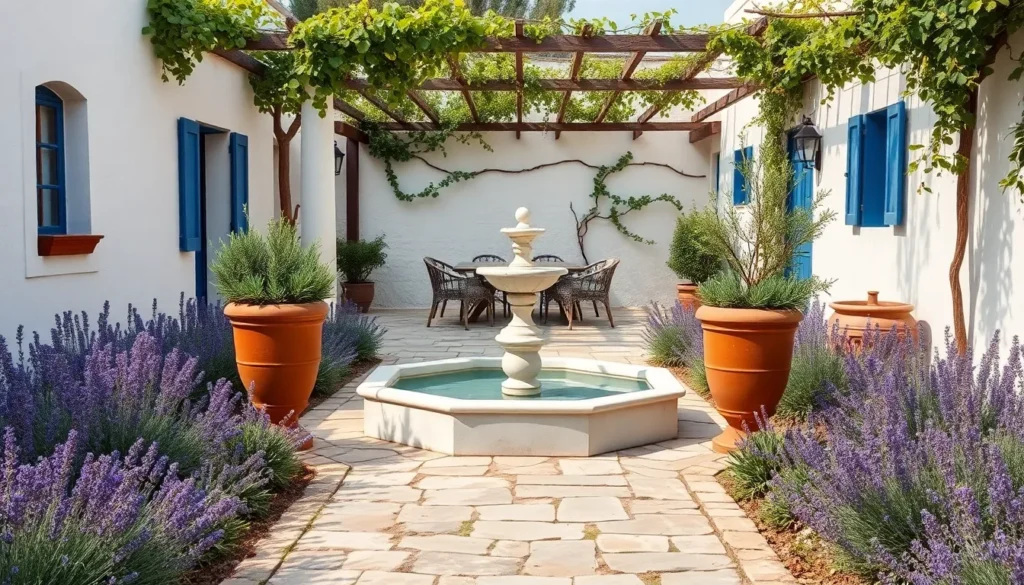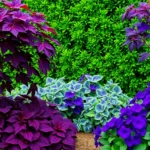Picture stepping into a Mediterranean paradise where whitewashed walls meet cascading bougainvillea and ancient olive trees cast dappled shadows across sun-warmed stone. Greek gardens aren’t just outdoor spaces – they’re living celebrations of timeless beauty that seamlessly blend functionality with stunning aesthetics.
We’ve discovered that creating an authentic Greek-inspired garden doesn’t require a Mediterranean climate or extensive renovation. The secret lies in understanding the key elements that define this captivating style: natural materials like weathered stone and terracotta, drought-resistant plants that thrive in sunny conditions, and architectural features that create intimate outdoor living spaces.
Whether you’re working with a sprawling backyard or a cozy patio, Greek garden design principles can transform any space into a serene retreat. From selecting the perfect herb garden layout to choosing statement pieces like classical urns and pergolas, we’ll show you how to capture that effortless Greek charm that makes every day feel like a vacation.
Create a Mediterranean Courtyard with Traditional Greek Elements
Transforming your outdoor space into an authentic Greek courtyard requires thoughtful placement of key architectural elements. We’ll guide you through incorporating the essential features that define traditional Mediterranean design.
Install a Central Water Feature or Fountain
Position a fountain as your courtyard’s focal point to capture the essence of ancient Greek gathering spaces. Traditional Greek courtyards featured central water elements that provided both practical cooling and aesthetic beauty during hot Mediterranean summers.
Choose materials that reflect authentic Greek design such as natural stone, aged terracotta, or classic white marble for your fountain structure. Tiered fountains work exceptionally well, mimicking the multi-level designs found in historic Greek villas and monastery courtyards.
Install a recirculating pump system to maintain continuous water flow while conserving resources. The gentle sound of flowing water creates the peaceful ambiance that makes Greek courtyards so inviting and helps mask urban noise pollution.
Surround your fountain with drought-resistant plantings like lavender, rosemary, or small olive trees in terracotta pots. This arrangement mirrors the practical yet beautiful approach Greeks have used for centuries in their courtyard gardens.
Use Natural Stone Flooring and Pathways
Select limestone or travertine for your primary flooring material to achieve the weathered, sun-bleached appearance characteristic of Greek courtyards. These natural stones develop beautiful patinas over time and remain cool underfoot during summer heat.
Create pathways using irregularly shaped flagstones rather than perfectly cut pavers to maintain an organic, aged appearance. Traditional Greek courtyards featured stones laid in natural patterns that followed the industry’s contours.
Install proper drainage beneath stone surfaces to prevent water accumulation and ensure longevity in various climate conditions. Greek courtyard design incorporates subtle slopes that direct rainwater toward planted areas or drainage points.
Fill joints between stones with decomposed granite or sand instead of concrete mortar for authentic texture and improved drainage. This traditional technique allows plants like thyme or oregano to naturally establish between stones, creating living pathways.
Add Whitewashed Walls and Blue Accents
Apply traditional lime-based whitewash to courtyard walls for the iconic bright white finish that reflects Mediterranean sunlight and keeps spaces cool. This centuries-old technique creates the distinctive chalky texture found throughout Greek islands and mainland villages.
Incorporate varying shades of blue through painted doors, window frames, and decorative elements to mirror the colors of the Aegean Sea and Greek flag. Use deeper navy blues for larger features and lighter sky blues for smaller accents and pottery.
Paint wooden furniture and architectural details in these classic blue tones to create cohesive color schemes throughout your courtyard space. Traditional Greek blue pigments were derived from local minerals, creating the distinctive weathered appearance we associate with authentic Mediterranean design.
Balance white and blue elements with natural wood tones from olive or cypress materials to prevent the color scheme from appearing too stark. This combination creates the warm, lived-in feeling that makes Greek courtyards so welcoming and comfortable.
Plant Native Greek Herbs and Aromatic Plants
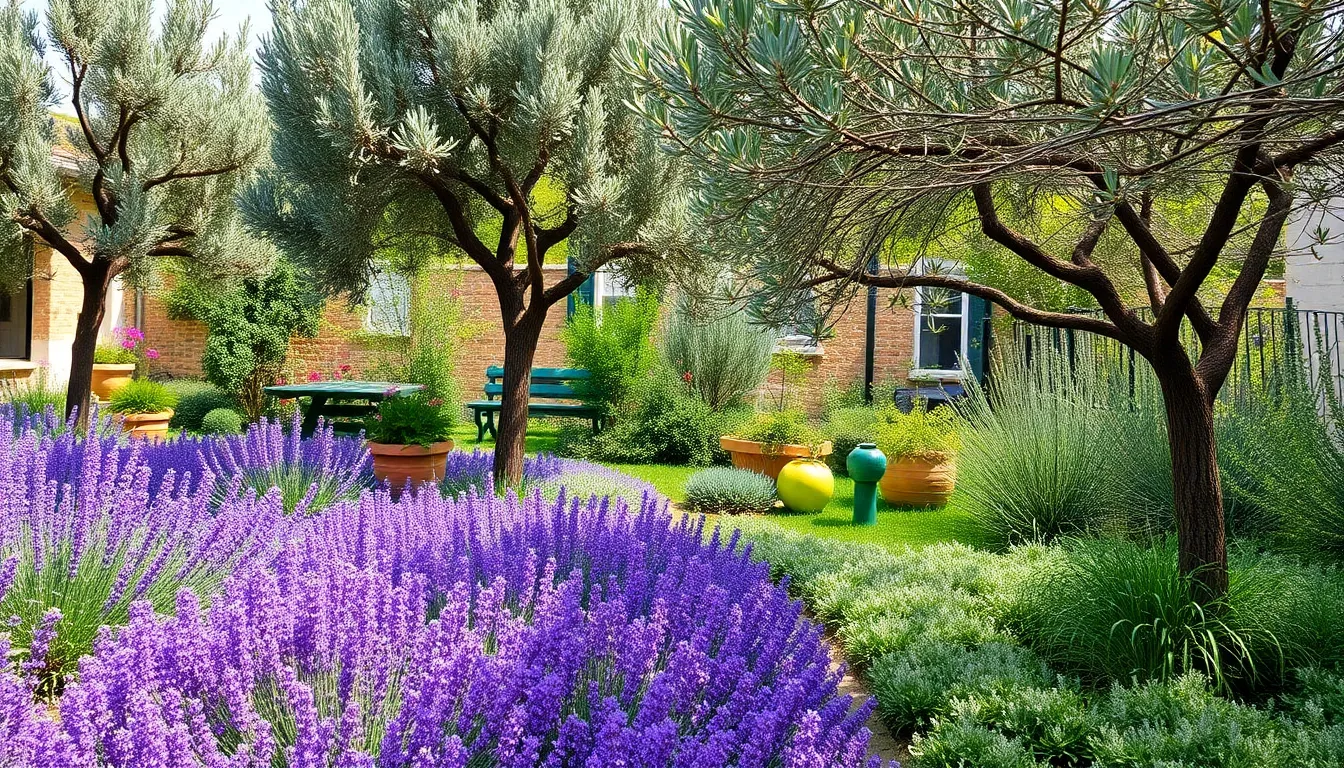
Authentic Greek gardens showcase the natural beauty of Mediterranean flora through carefully selected herbs and aromatic plants. These hardy species thrive in dry conditions while filling your outdoor space with delightful fragrances.
Grow Lavender, Rosemary, and Oregano
Lavender transforms any garden into a fragrant sanctuary with its distinctive purple blooms and calming scent. We recommend planting English lavender or French lavender varieties that flourish in well-draining soil and full sunlight. Position these plants along pathways where visitors can brush against them and release their essential oils.
Rosemary serves dual purposes as both ornamental and culinary herb in traditional Greek garden design. Select upright varieties like ‘Tuscan Blue’ or prostrate forms such as ‘Huntington Carpet’ depending on your space requirements. Plant rosemary near outdoor cooking areas where you’ll easily access fresh sprigs for Mediterranean dishes.
Oregano completes the essential trio of Greek herbs with its robust flavor and small white flowers that attract beneficial pollinators. Choose Greek oregano specifically, as it offers the most authentic taste and aromatic qualities. Space oregano plants 12 inches apart to allow proper air circulation and prevent fungal issues.
Include Olive Trees as Focal Points
Olive trees embody the essence of Greek culture and create stunning centerpieces in any Mediterranean garden design. We suggest selecting dwarf varieties like ‘Arbequina’ or ‘Picholine’ for smaller spaces, while standard trees work beautifully in larger landscapes. Position olive trees strategically to provide natural shade for seating areas or dining spaces.
Container planting offers flexibility for those with limited garden space or harsh winter climates. Choose large ceramic pots or wooden planters that complement your garden’s aesthetic while ensuring proper drainage. Move potted olive trees to protected areas during extreme weather conditions.
Pruning maintains the classic Mediterranean silhouette that makes olive trees such attractive focal points. Trim branches annually during late winter to encourage healthy growth and maintain the tree’s natural shape. Remove any dead or crossing branches to improve air circulation and prevent disease.
Plant Thyme and Sage for Ground Cover
Thyme creates aromatic carpets that release pleasant scents when stepped upon or brushed against. We recommend creeping thyme varieties like ‘Elfin’ or ‘Red Creeping’ that spread naturally across garden beds and between stepping stones. Plant thyme in full sun locations with excellent drainage to prevent root rot.
Sage provides silvery foliage contrast against darker green plants while offering culinary and medicinal benefits. Choose common sage for cooking purposes or ornamental varieties like ‘Purple Sage’ for visual interest. Space sage plants 18 to 24 inches apart to accommodate their mature spread of 2 to 3 feet.
Ground cover herbs reduce maintenance while adding texture and fragrance to your Greek garden design. Establish these plants in spring after the last frost date for optimal root development. Water newly planted herbs regularly during their first growing season, then reduce irrigation as they become established and drought tolerant.
Design with Classic Greek Architectural Features
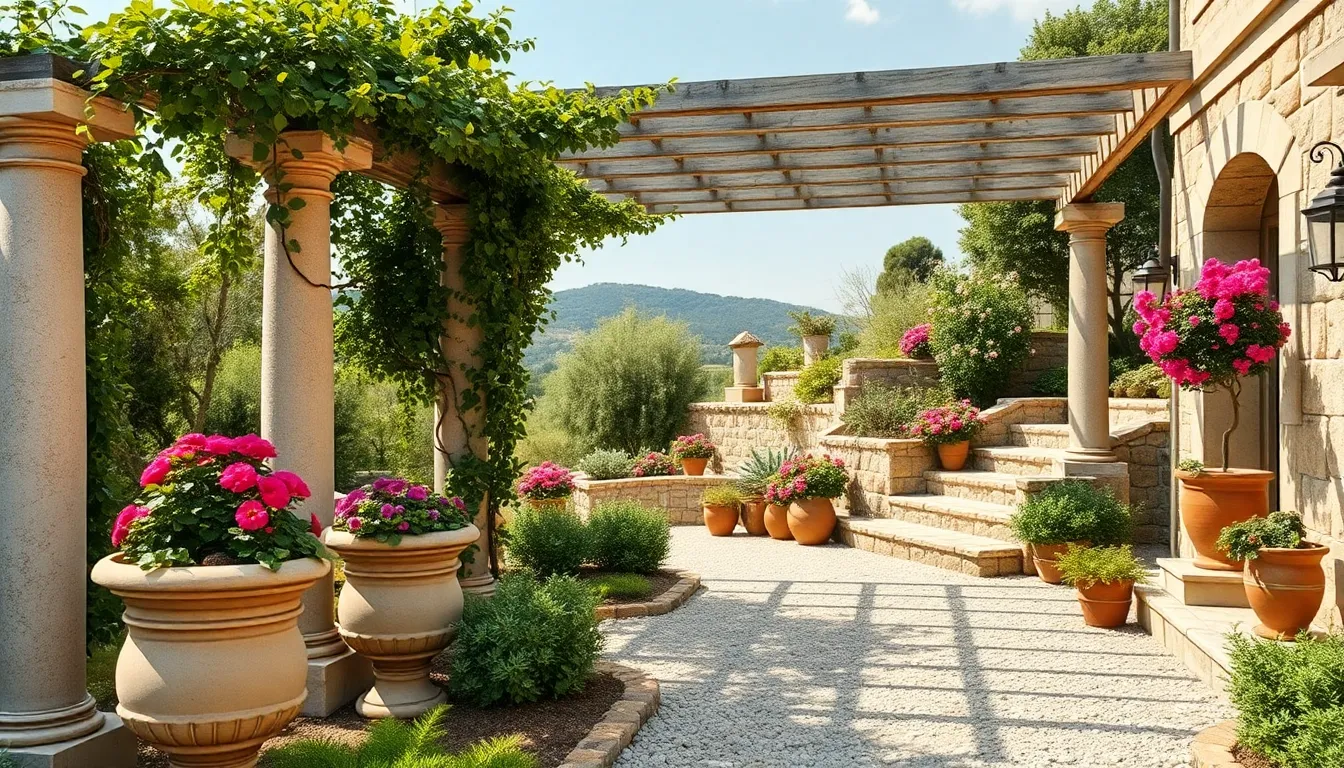
Greek architectural elements transform any outdoor space into a timeless Mediterranean retreat. These structural features create the foundation for an authentic garden that captures the essence of ancient Greece.
Build Stone Pergolas and Arbors
Stone pergolas serve as stunning focal points that define outdoor spaces while providing essential shade and structure. We recommend constructing these pergolas with natural stone materials to support climbing plants like ivy and jasmine, which add both beauty and cooling shade to your garden sanctuary.
Entrance features benefit significantly from strategically placed arbors that create dramatic entry points. These stone structures frame pathways and garden transitions, establishing clear boundaries between different garden zones while maintaining the classical Greek aesthetic throughout your outdoor space.
Install Greek Column Planters
Classic columns bring instant elegance and historical authenticity to modern garden designs. We suggest incorporating planters shaped like traditional Greek columns to house small plants, herbs, or colorful Mediterranean blooms that complement the architectural theme.
Marble and stone materials work best for these column planters, aligning perfectly with traditional Greek construction methods. These elevated planters create visual interest at varying heights while showcasing your favorite plants in a way that honors ancient Greek design principles.
Create Terraced Garden Levels
Mediterranean terracing provides both practical drainage answers and stunning visual appeal across sloped landscapes. We recommend building multiple levels that accommodate different plantings and seating areas, creating intimate spaces that mirror the hillside gardens found throughout Greece.
Gravel walkways replace traditional lawns for easier maintenance and a more authentic Mediterranean appearance. These pathways connect each terraced level while reducing water requirements and providing better drainage during heavy rainfall.
Terracotta pots enhance each level with vibrant color and traditional charm. We place these containers strategically across terraces to create focal points and add Mediterranean flair with drought resistant plants that thrive in these elevated positions.
Choose Drought-Resistant Plants for Authentic Greek Landscaping
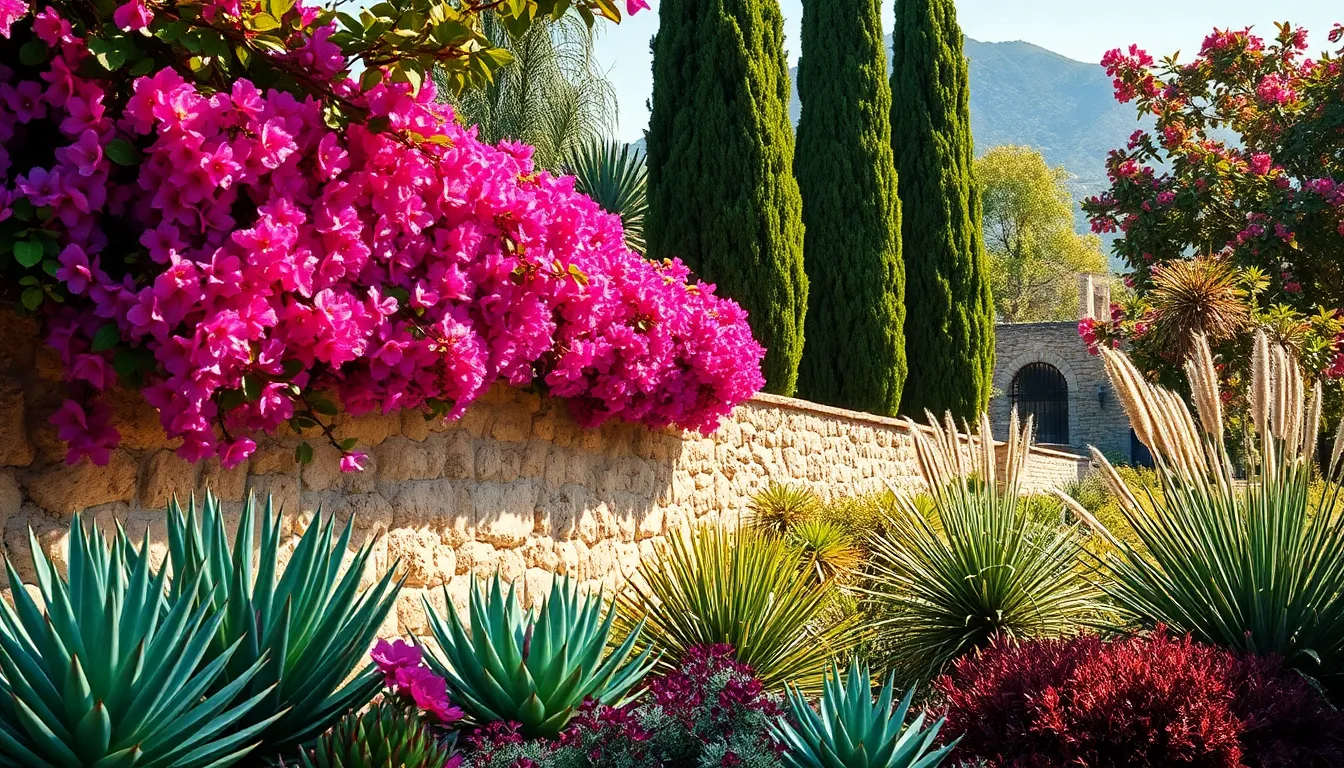
Selecting the right plants creates the foundation for an authentic Greek garden that thrives with minimal water requirements. Mediterranean plants naturally adapt to dry conditions while maintaining the visual appeal that defines classic Greek landscapes.
Select Bougainvillea for Vibrant Color
Bougainvillea transforms any Greek garden with its spectacular blooms that cascade over walls and pergolas. We recommend choosing varieties in traditional Mediterranean colors like magenta, purple, or white to maintain authenticity. These resilient climbers require minimal watering once established and bloom continuously throughout warm months.
Training bougainvillea along stone walls or wooden trellises creates stunning vertical displays that mirror traditional Greek villages. Position these plants in full sun locations where they’ll receive at least six hours of direct sunlight daily. Pruning after each flowering cycle encourages bushier growth and more abundant blooms.
Plant Cypress Trees for Vertical Interest
Cypress trees provide the quintessential Mediterranean silhouette that defines Greek landscapes across the islands and mainland. We suggest planting Italian cypress (Cupressus sempervirens) in strategic locations to create natural privacy screens and dramatic focal points. These columnar evergreens reach heights of 40 to 60 feet while maintaining their narrow profile.
Spacing cypress trees 8 to 10 feet apart creates effective windbreaks that protect more delicate plants in your garden. Their dark green foliage contrasts beautifully with whitewashed walls and terra cotta elements. These trees tolerate poor soil conditions and require watering only during their first two growing seasons.
Use Succulents and Mediterranean Grasses
Succulents offer low maintenance answers that complement the rocky terrain typical of Greek islands. We recommend incorporating varieties like agave, aloe, and prickly pear cactus to create textural interest without demanding frequent irrigation. These plants store water in their leaves and stems, making them perfect for xerophytic gardens.
Mediterranean grasses like fountain grass and feather reed grass add movement and softness to structured Greek garden designs. Plant these ornamental grasses in clusters of three or five for maximum visual impact. Their silvery plumes catch sunlight and create gentle rustling sounds that enhance the peaceful atmosphere of your outdoor retreat.
Combining different heights and textures of drought resistant plants creates layered compositions that remain attractive year round. Position taller succulents near architectural features while using grasses to soften pathway edges and transition areas between hardscaped elements.
Incorporate Traditional Greek Garden Containers and Pottery
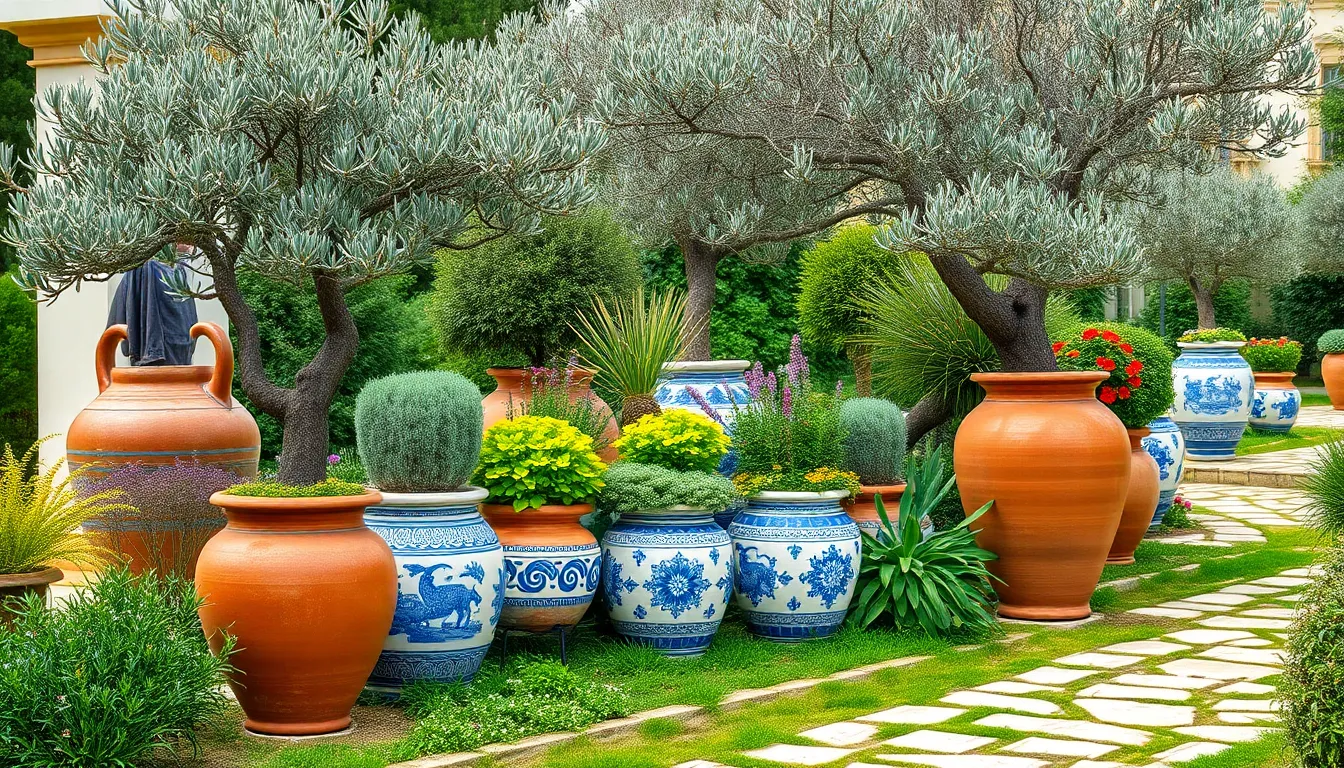
Greek gardens reach their full potential when we integrate authentic containers that echo ancient Mediterranean traditions. These carefully chosen vessels transform ordinary plant displays into stunning focal points that capture the timeless beauty of classical Greek design.
Display Large Terracotta Urns and Amphorae
Large terracotta urns and amphorae serve as the cornerstone of authentic Greek garden design, bringing ancient elegance to modern outdoor spaces. We recommend positioning these iconic containers as statement pieces throughout your garden, where they’ll naturally draw the eye and create visual anchors. Plant olive trees in oversized amphorae to establish dramatic focal points that honor traditional Greek cultivation practices.
Fill medium-sized terracotta urns with aromatic herbs like lavender and rosemary, which thrive in these breathable clay vessels while providing both fragrance and culinary value. Weather-resistant terracotta develops a beautiful patina over time, adding character and authenticity to your Greek garden aesthetic. Consider grouping urns of varying sizes near seating areas or entrance points to create welcoming displays that immediately establish your garden’s Mediterranean identity.
Use Ceramic Pots with Greek Motifs
Ceramic pots adorned with traditional Greek motifs add cultural richness and visual storytelling to your garden industry. We suggest selecting containers featuring mythological figures, geometric patterns, or classic Greek key designs that reflect the artistic heritage of ancient Greece. Position these decorative vessels strategically around pathways and gathering areas where their intricate details can be fully appreciated.
Blue and white ceramic pots echo the iconic colors of the Aegean Sea while providing perfect homes for smaller herbs and flowering plants. Geometric-patterned containers work beautifully when planted with cascading varieties like trailing thyme or creeping oregano. Mix different motif styles throughout your space to create visual interest while maintaining the cohesive Greek theme that ties your entire garden together.
Arrange Containers at Different Heights
Tiered container arrangements create ever-changing visual interest and maximize planting space in your Greek garden design. We achieve this layered effect by using pedestals, plant stands, and naturally varying terrain to establish multiple height levels throughout the space. Place taller amphorae on ground level with medium urns elevated on stone pedestals and smaller decorative pots positioned on tiered plant stands.
Staggered heights allow each container to be fully visible while creating depth and texture that draws visitors through your garden space. Consider using natural stone blocks or wooden plant stands to elevate certain containers, ensuring the supports complement your overall Greek aesthetic. This vertical layering technique also improves plant health by ensuring adequate light reaches all levels while creating the sophisticated, well-planned appearance characteristic of traditional Mediterranean gardens.
Add Greek-Inspired Outdoor Living Spaces
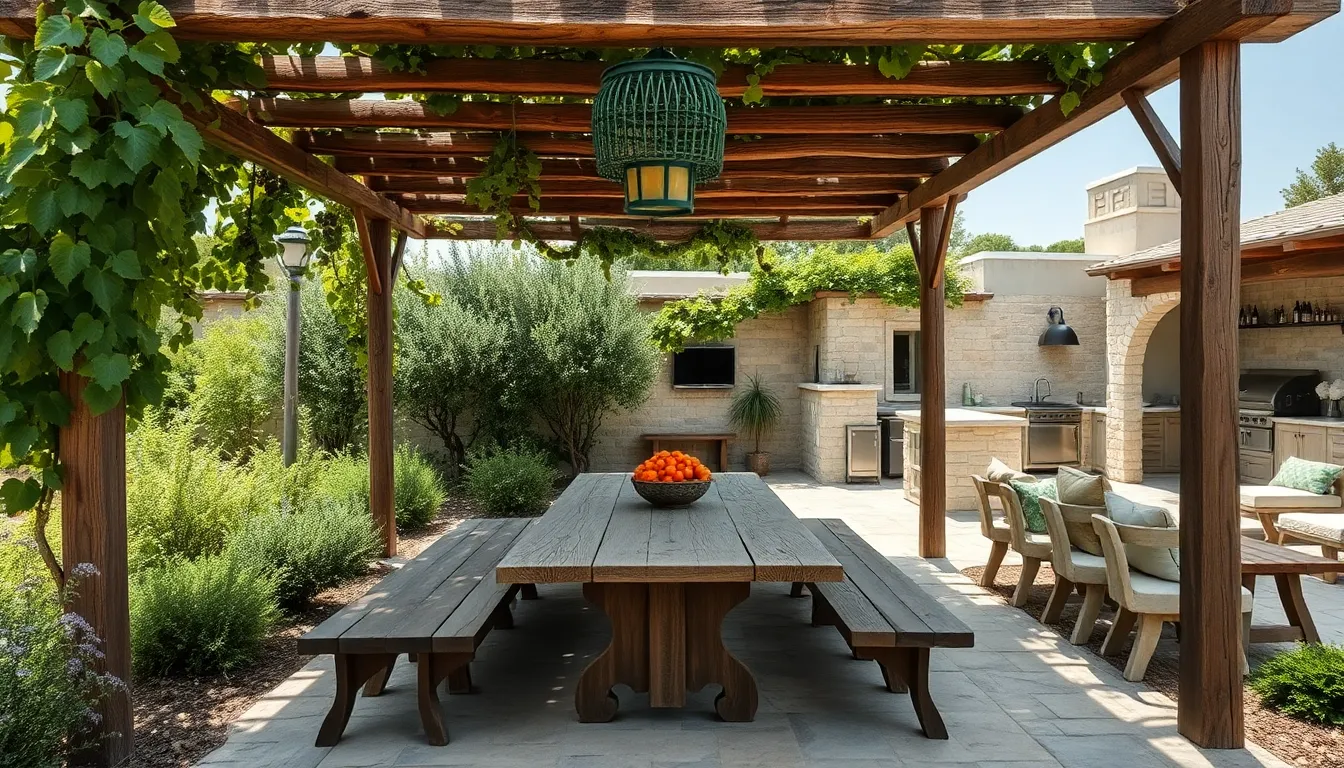
Transform your garden into a Mediterranean haven by creating dedicated areas for relaxation and entertainment that capture the essence of traditional Greek outdoor living.
Create Shaded Dining Areas with Grape Vines
Pergolas become the cornerstone of authentic Greek dining spaces when draped with cascading grape vines. We recommend installing wooden or stone pergolas that provide the perfect framework for vines to create natural shade while offering dappled sunlight that enhances the dining experience. Grape vines not only deliver practical shade but also add an authentic agricultural element that’s been central to Greek culture for thousands of years.
Rustic dining furniture completes the traditional taverna atmosphere we’re aiming to achieve. Position weathered wooden tables and benches beneath your vine covered pergola to evoke the charm of countryside Greek eateries. The combination of natural materials and organic shade creates an intimate setting that encourages long, leisurely meals with family and friends.
Install Built-In Stone Seating
Stone seating integrates seamlessly into Greek garden design while providing permanent, weather resistant furniture answers. We suggest using limestone or marble to construct built in benches that follow the natural contours of your garden paths and gathering areas. These installations become architectural features that enhance the overall structure of your outdoor space.
Pathways connecting your stone seating areas should incorporate the same materials to maintain design continuity throughout the garden. Natural stone creates smooth transitions between different zones while reflecting the ancient Greek appreciation for harmony and balance. Columns can frame seating areas to add classical architectural elements that reinforce the Greek aesthetic.
Design Outdoor Kitchen Areas
Mediterranean inspired cooking spaces bring the social heart of Greek culture into your garden setting. We recommend incorporating terracotta elements throughout your outdoor kitchen design, from decorative backsplashes to storage containers that hold cooking utensils and spices. Stone countertops and built in grilling areas create functional workspaces that can handle the demands of outdoor entertaining.
Functional design principles ensure your Greek inspired kitchen serves both aesthetic and practical purposes. Position prep areas near herb gardens so fresh oregano, thyme, and rosemary remain within easy reach during cooking. Storage answers using traditional amphorae and ceramic vessels keep cooking essentials organized while maintaining the authentic Mediterranean appearance you’ve cultivated throughout your garden space.
Use Natural Materials for Authentic Greek Garden Paths
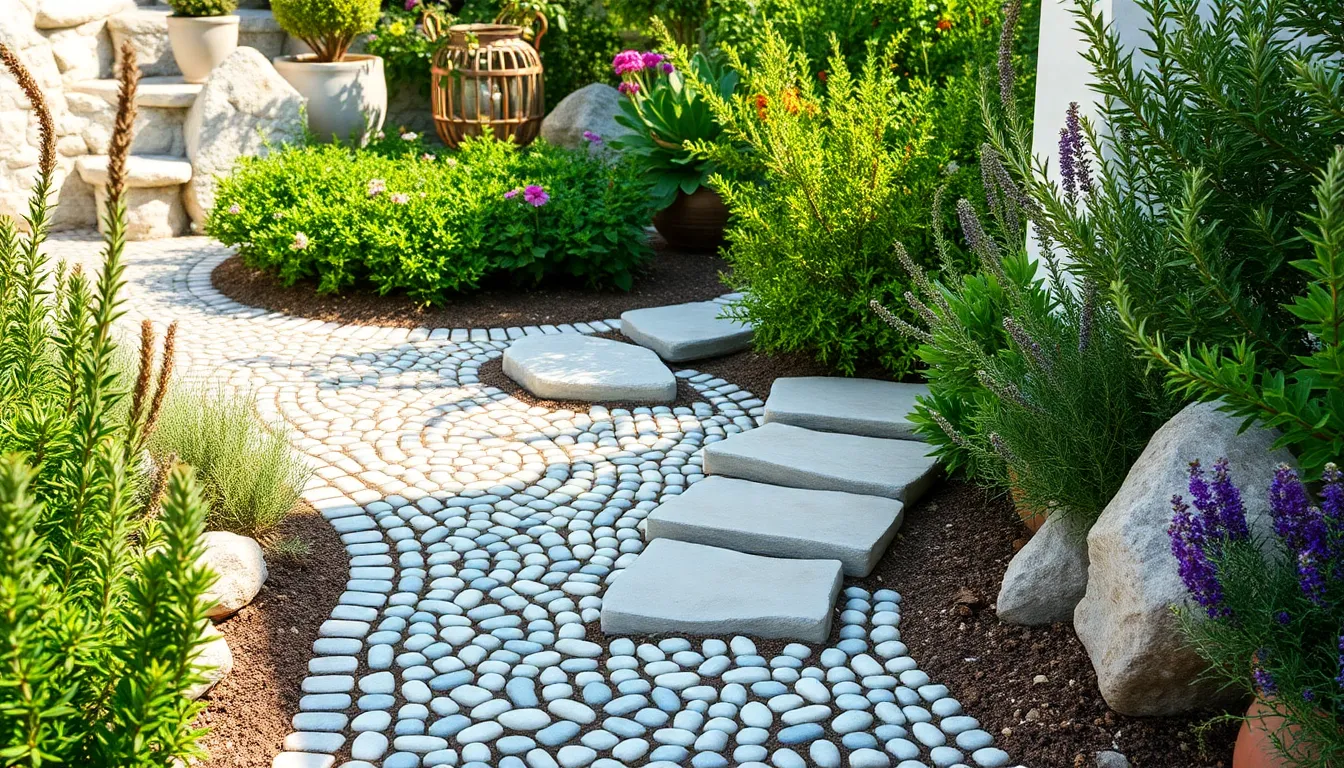
Authentic Greek garden paths connect outdoor spaces while maintaining the timeless Mediterranean aesthetic that defines traditional Greek design. Natural materials create the foundation for pathways that seamlessly blend functionality with beauty.
Lay Pebble Mosaic Walkways
Pebble mosaic walkways transform ordinary paths into stunning works of art using small stones arranged in traditional Greek patterns. We recommend collecting smooth river stones in various sizes and colors to create intricate geometric designs that reflect ancient Greek craftsmanship. This eco-friendly method requires sorting pebbles by size and color before laying them in sand or mortar base for stability.
Traditional Greek pebble mosaics often feature wave patterns, spirals, and geometric shapes that we can recreate using contrasting colors like white marble chips and dark slate pieces. The visual appeal of these walkways increases dramatically when we incorporate borders made from larger stones or terra cotta tiles. Installation becomes easier when we work in small sections, allowing each area to set properly before moving to the next.
Install Flagstone Stepping Stones
Flagstone stepping stones provide rustic charm while guiding visitors through garden spaces in true Greek fashion. We select irregularly shaped pieces of natural stone that complement the existing industry and create interesting visual rhythms along pathways. These stones work exceptionally well when spaced at comfortable walking distances and surrounded by aromatic herbs or ground cover plants.
Natural flagstone weathers beautifully over time, developing a patina that enhances the authentic Mediterranean appearance we’re seeking. We recommend choosing stones that are at least 2 inches thick to ensure stability and longevity in outdoor conditions. Placement becomes crucial for both safety and aesthetics, so we level each stone carefully and fill gaps with crushed stone or decorative gravel.
Create Gravel Pathways with Herb Borders
Gravel pathways lined with Mediterranean herbs offer both fragrance and traditional Greek garden charm throughout our outdoor spaces. We select crushed stone or pea gravel in neutral tones that complement the surrounding industry while providing excellent drainage. Rosemary, thyme, and oregano planted along pathway edges release delightful scents when brushed against during garden walks.
These herb borders serve multiple purposes by defining pathway edges, providing culinary ingredients, and attracting beneficial pollinators to our Greek garden. We maintain consistent width by installing subtle edging materials like natural stone or recycled brick to contain both gravel and herbs. Regular trimming of herb borders keeps pathways neat while encouraging fresh growth and maintaining the aromatic qualities that make these walkways so appealing.
Design Water-Wise Greek Garden Zones
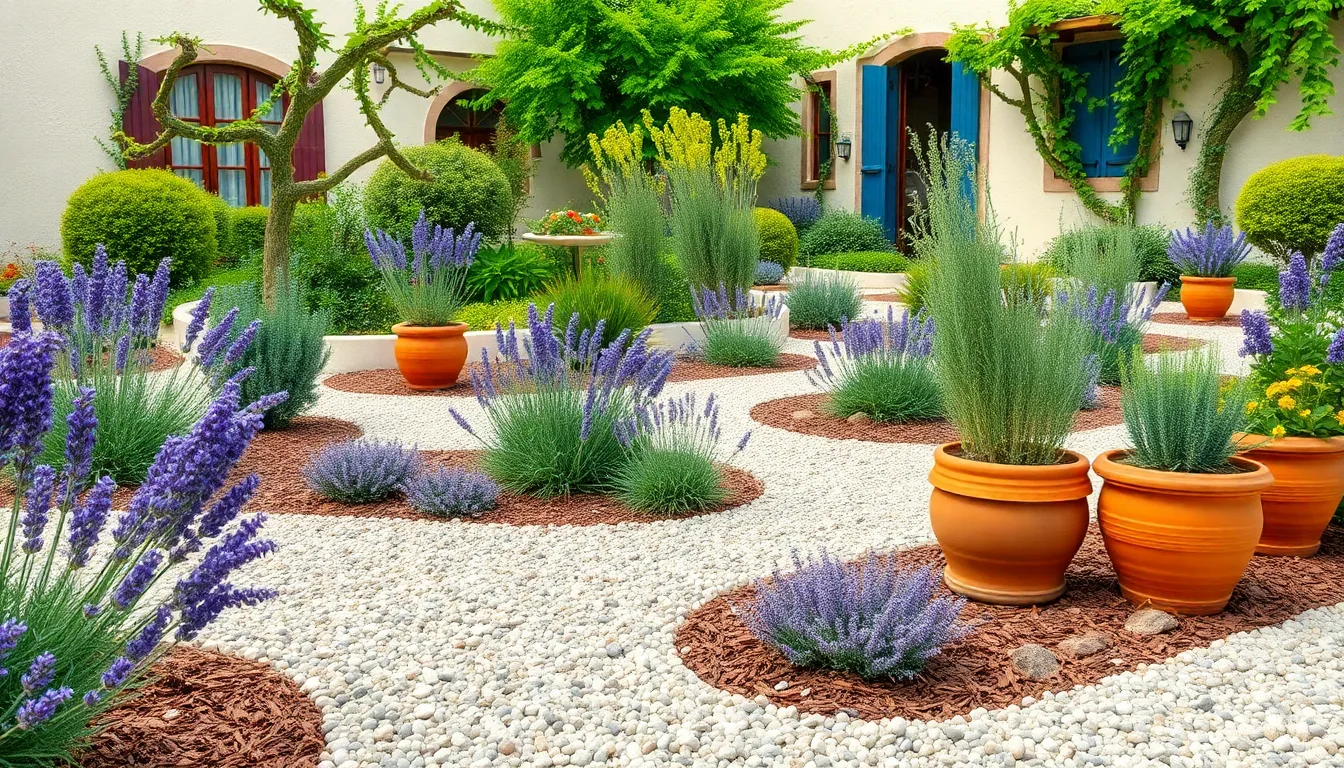
Creating an authentic Greek garden requires thoughtful water management strategies that honor the Mediterranean climate’s natural patterns. We’ll establish distinct zones that work together to maximize water efficiency while maintaining the stunning beauty of traditional Greek landscapes.
Plan Xerophytic Plant Groupings
Drought tolerant plants form the backbone of any successful Greek garden zone. We recommend grouping lavender, rosemary, and thyme together in sunny areas where their similar water needs create efficient irrigation patterns. These aromatic herbs not only conserve water but also provide the authentic Mediterranean fragrance essential to Greek garden design.
Strategic plant placement maximizes visual impact while minimizing water waste. We suggest clustering xerophytic varieties like sage and oregano near pathways where their textures and scents can be appreciated daily. Positioning these plants together allows us to create microclimates that support each species while reducing overall maintenance requirements.
Visual groupings enhance the garden’s aesthetic appeal through thoughtful arrangement. We place taller drought resistant plants like cypress or olive trees as backdrop anchors, with medium height lavender bushes in the middle tier, and low growing thyme carpets in the foreground. This layered approach creates depth while ensuring each plant receives appropriate water levels.
Install Efficient Drip Irrigation Systems
Drip irrigation delivers water directly to plant roots, reducing evaporation and runoff that typically occurs with traditional sprinkler systems. We design these systems to target exact zones, ensuring each area receives precise moisture amounts based on plant requirements rather than applying water uniformly across the entire garden.
Zone based irrigation optimizes water distribution throughout different garden areas. We install separate drip lines for high water demand sections near the house and low water zones filled with native Mediterranean plants. This targeted approach allows us to adjust watering schedules and volumes according to seasonal changes and plant maturity.
System efficiency increases dramatically when we incorporate timers and moisture sensors into our drip irrigation setup. We program these devices to water during early morning hours when evaporation rates are lowest, maximizing water absorption while preventing fungal issues that can occur with evening watering schedules.
Use Mulch and Ground Cover Strategically
Organic mulch retains soil moisture while suppressing weeds that compete with our carefully chosen Greek garden plants. We apply a three inch layer of shredded bark or compost around established plantings, keeping mulch several inches away from plant stems to prevent rot and pest issues.
Inorganic mulch options like gravel and crushed stone provide excellent water retention while improving the Mediterranean aesthetic. We use light colored gravel around succulents and heat loving herbs, as these materials reflect sunlight and help regulate soil temperature during intense summer months.
Ground cover plants fill gaps between larger specimens while reducing water evaporation from exposed soil. We plant creeping thyme and sedum varieties that spread naturally, creating living carpets that require minimal irrigation once established. These low growing options add texture and seasonal interest while serving practical water conservation purposes.
Strategic placement of mulch and ground cover creates cohesive zones that support our overall Greek garden vision. We transition from gravel mulch in formal areas near architectural features to organic mulch in herb growing zones, then to living ground covers in naturalistic sections that blend with surrounding industry elements.
Conclusion
Creating your own Greek garden sanctuary is more achievable than you might think. We’ve shown you how to blend authentic Mediterranean elements with practical design answers that work in any climate or space size.
From drought-resistant plantings and natural stone pathways to traditional pottery and water-wise irrigation systems these timeless design principles will transform your outdoor space into a serene retreat. The key lies in selecting the right combination of aromatic herbs architectural features and natural materials.
Your Greek-inspired garden will become a peaceful escape that captures the essence of Mediterranean living while requiring minimal maintenance. Start with one or two elements that speak to you most and gradually build your own slice of Greek paradise.
Frequently Asked Questions
Do I need a Mediterranean climate to create a Greek-inspired garden?
No, you don’t need a Mediterranean climate to create a beautiful Greek-inspired garden. The key is selecting the right drought-resistant plants, using natural materials like stone and terracotta, and incorporating traditional Greek architectural elements. With proper plant selection and design choices, you can capture the essence of a Greek garden in any climate zone.
What are the essential plants for an authentic Greek garden?
Essential plants include aromatic herbs like lavender, rosemary, oregano, thyme, and sage. Olive trees (dwarf varieties for smaller spaces) serve as stunning focal points. Bougainvillea adds vibrant color, while cypress trees provide iconic silhouettes. Succulents and Mediterranean grasses offer low-maintenance options that create beautiful textural contrasts throughout the garden.
How do I create a Mediterranean courtyard design?
Start with a central water feature like a fountain as your focal point. Use natural stone for flooring and pathways, install whitewashed walls with blue accents, and incorporate Greek architectural elements like columns or pergolas. Add terracotta pots and urns filled with aromatic herbs to complete the authentic Mediterranean courtyard atmosphere.
What materials should I use for Greek garden pathways?
Use natural materials like pebble mosaics made from smooth river stones, flagstone stepping stones for rustic charm, or gravel pathways. Line gravel paths with Mediterranean herbs like lavender or rosemary for added fragrance. These materials create authentic-looking walkways that blend beauty with functionality while maintaining the Greek aesthetic.
How can I manage water efficiently in a Greek garden?
Create distinct planting zones grouping drought-tolerant plants together. Install drip irrigation systems to deliver water directly to plant roots. Use mulch and ground cover plants like thyme to retain soil moisture and suppress weeds. Plant in spring for optimal establishment, and select native Mediterranean plants that naturally require less water.
What containers work best for Greek garden design?
Large terracotta urns and amphorae make excellent statement pieces, especially when planted with olive trees. Medium-sized terracotta pots work well for aromatic herbs like lavender and rosemary. Choose ceramic pots with Greek motifs, mythological figures, or geometric patterns to add cultural authenticity and visual interest to your garden design.
How do I incorporate Greek architectural features?
Build stone pergolas and arbors to define spaces and provide shade. Use Greek column planters made from marble or stone for elegant plant displays. Create terraced garden levels for better drainage and visual appeal. Install whitewashed walls with blue accents, and add archways or decorative stonework to enhance the classical Greek atmosphere.
Can I create a Greek garden in a small space?
Absolutely! Use dwarf olive tree varieties, select compact herbs like thyme for ground cover, and utilize vertical space with climbing bougainvillea on trellises. Choose smaller terracotta containers and focus on key elements like a small water feature, pebble mosaic accents, and carefully selected drought-resistant plants to maximize impact in limited space.

